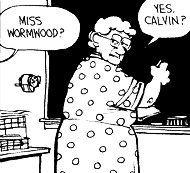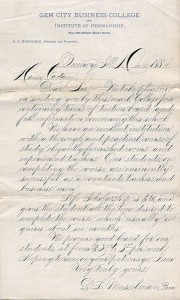Curse you cursive!
Okay, full confession. I’m kind of a wimp when it comes to authority. Always have been.
Cop pulls me over and I feel like I’m eight years old. Getting called into the principal’s office when I was actually eight years old? Reduced me to a gibbering, cowardly mass.
The number of times that I’ve actually rebelled in my life? Standing up to the metaphorical Man? You can count my Easy Rider moments on one hand.
One of those times? Refusing to learn cursive.
Yup. Way back in the shadowy gothic recesses of a 1970s Midwestern elementary school, I  stared down one of those teachers that inspired Calvin and Hobbes’ Miss Wormwood.
stared down one of those teachers that inspired Calvin and Hobbes’ Miss Wormwood.
My recollection of the conversation goes something like this: Her: “It’s time to learn how to write cursive, kids!”
Me: “I already know how to write just fine. I don’t want to learn how to write two different ways.”
Her: “Cursive is how grown-ups write.” Me: “That makes no sense at all and I’m not doing it.”
The weird part is that I actually stuck to my guns.
In an age when cursive was one of those rites of passage you took for granted — like multiplication tables and smallpox vaccination scars — I went all Bartleby the Scrivener on the Education Machine.
The Plattsburgh Press-Republican is reporting this weekend that I wasn’t just a rebel, I was a pioneer.
“[Cursive] may very well be a skill that is going to provide less and less usefulness as we enter the digital age,” Minerva central school principal Heidi Kelly told the newspaper.
Indeed, more and more schools are shifting time and energy away from “handwriting” and “cursive” and focusing instead on things like, you know, knowledge and creative thinking.
Let me say, as an aside, that I have nothing against artful penmanship. One of my good friends is Gail Brill, the incredibly talented calligrapher in Saranac Lake. I’m a big fan. That’s why we have art classes.
And I get it. For some folks, the decline in penmanship is a microcosm of the vast American malaise, the great unraveling, the undisciplined, sloppy heart of Who We’ve Become.
But here’s the truth. My best ideas aren’t just printed. They’re scrawled. They’re scratched out on the backs of napkins and parking stubs and Stewarts receipts. I like it that way.
And another truth is that for millions of kids — boys, I suspect, in particular — the finicky, deskbound act of getting those curves and looping lines just exactly right is pure torture.
This is one education tradition best consigned to the 19th century.







.png)

Standing up to the Man? But you ARE the Man(n).
I learned cursive, poorly, in elementary school and then later had to learn how to print rapidly in block letters for work and I can no longer write in cursive without great effort.
I WAS quite good at replicating my mother’s cursive writing for short note, though. I bet I still can.
I never rebelled about cursive – I could just never do it (well enough to be deciphered). Has to do with fine motor coordination, I believe.
A pair of thoughts:
As an artist I know that the hand/eye skills learned in writing cursive are the same skills necessary for drawing. I think it is a good thing for children to learn and practice that.
Scrawling notes on a napkin that only you need to read is fine but when your aim is to write a note that someone else is to read your writing needs to conform (at least minimally) to an standard common to both you and the reader. The key concept is ‘communication’. I used to work with a guy who’s handwriting was atrocious, to the point that sometimes even he couldn’t read it. I know that we use handwritten notes less than we did but I’m not sure that abandoning handwriting altogether is a good idea.
I think the whole thing broke down when I was a youngster in the sixties. I don’t know how older folks learned cursive, but I think we were victim to the literary equivalent of “new math”, and I’m pretty sure that almost no one of my generation learned cursive…at least not beautifully. I have envied those who could write beautifully and effortlessly, but that had nothing to do with what we were taught in grade school.
I agree with Jim Bullard in that cursive writing, like many other subjects formerly taught and learned in America’s schools, is important not so much for its own sake but as a foundation for other, more useful skills. You can mock all you like Brian, but “Who We’ve Become” is not always better than we used to be.
It’s true that your handwriting is less important in today’s world, however, all things being equal – having legible and “artistic” scrawl can be an asset.
OK, so don’t learn to write in cursive. But when the zombie virus strikes it will be a survival advantage. Being able to write a quick note in cursive will give you valuable time to get away from the infected breaking down your door. Where will your digital get you then with no wireless available?
I actually own the zombie survival guide and nowhere does it mention cursive as a necessary skill. On the other hand, if Lovecraftian Old Ones invade earth, then the ability to decipher old illuminated manuscripts may, indeed, be crucial.
Of course reading those books drives you almost as mad as learning cursive does, so that’s no good….
–Brian, NCPR
Okay, I’m convinced that good old fashioned writing skills are super important. So I’m going to brush up on my Sumerian script, hieroglyphs, and pictographs.
Cursive is better. Why? It’s quicker. If you have to take notes a lot — if, for example, you’re a journalist — cursive is superior.
I hope, Brian, you at the very least sign checks and other legal documents in cursive.
I learned cursive but never was able to do it as well as my mother and father who learned it using something called the Palmer method.
Beautiful handwriting is something to behold and is easy to read.
Old enough to remember one of my earliest jobs as a bank teller and having some customers who signed with the (X) mark.
I wonder if that is still allowed today.
OK – raise your hand if you remember The Palmer Method. Standard 1950s curriculum in rural Saratoga County. Wilton School #4 (now burned down and replaced by Ballard Rd. School), two grades in a room, eight kids in a class.
I have two stories. First, I could write cursive midday through first grade. When I signed my name to a worksheet in cursive, my teacher shut me down. Yup, not allowed to write cursive till you
I learned cursive in catholic school late ’50s early 60’s. Started with those big pencils Bill Cosby said you have to rest on your shoulder. Palmer Method. I can hardly read my own cursive these days. It is becoming a lost art.
OK – raise your hand if you remember The Palmer Method. Standard 1950s curriculum, at least in rural Saratoga County. Wilton School #4 (now burned down and replaced by Ballard Rd. School), two grades in a room, eight kids in a class.
I have two stories. First, I could write cursive midway through first grade. When I signed my name to a worksheet in cursive, my teacher shut me down. Yup, not allowed to write cursive till you LEARNED IT THE RIGHT WAY. Which was The Palmer Method, workbooks where you copied those loops over and over and over, being very careful to use your WHOLE ARM!
OK – raise your hand if you remember The Palmer Method. Standard 1950s curriculum, at least in rural Saratoga County. Wilton School #4 (now burned down and replaced by Ballard Rd. School), two grades in a room, eight kids in a class.
I have two stories. First, I could write cursive midway through first grade. When I signed my name to a worksheet in cursive, my teacher shut me down. Yup, not allowed to write cursive till you LEARNED IT THE RIGHT WAY. Which was The Palmer Method, workbooks where you copied those loops over and over and over, being very careful to use your WHOLE ARM! Imagine, spending class time that way and being graded on your Palmer Method. Do I write cursive now? A little yes, a little no.
I am a “wimp” when it comes to authority also. I always thought more of it as respect for authority rather than wimpishness but maybe you have a point. I guess I am just a “yes” man. I took penmanship where we learned cursive writing in Catholic school. It was taught by our principal at the time a christian brother. Talk about being reduced to a “cowardly mass” all you had to do was have Brother Cashmere look at you (no kidding that was his name!).
I have to know, Paul.
Did he make you feel sheepish?
Correction dan. I think the question is, did he get your goat?
I don’t know a darned thing about the Palmer Method or the Rhythm Method or any of those other things they teach in Catholic school but I do know something about drawing and calligraphy: the proper tool makes a world of difference. The ball point pen is a functional tool but it is a poor instrument for placing an elegant mark. Variation in pressure or direction of stroke make no difference in the quality of line.
The humble graphite pencil in the appropriate hardness matched with quality paper that has good tooth will give excellent results, and mistakes can be erased. The quill pen or nib pen used with good ink on vellum or parchment leads to excellent results with a small amount of effort. The ability to vary line thickness with change in pressure makes all the difference.
As with so much else, we have been reduced to using inferior tools and materials to save a little time and money.
You got me, khl.
Guys. If you keep picking on me Brother Cashmere is going to have to take you into his office and close the door. We still had the ruler in those days!
I can tell you he didn’t wear sweaters. He wore an all black robe with a white collar like you would see for a priest (the collar part some also have big white collars). Kind of like this guy (he even looks kinda mad like our principal always did!):
http://www.oldnick.org.au/wordpress/wp-content/uploads/2009/05/cb12-small.jpg
I taught cursive to all my kids (home schooled). I thought of it as a good discipline and to be able to sign their name!
Kathy – not only good discipline, but teaching other qualities such as perseverance, attention to detail, and a sense of accomplishment in mastering a sometimes challenging skill. It is also faster than manually printing. Think about all those folks we have known with an 8th grade education and “CEO” penmanship. That masterful writing style is also a source of credibility.
Boy, it’s not hard to guess who has good handwriting and who writes like a doctor on this thread!